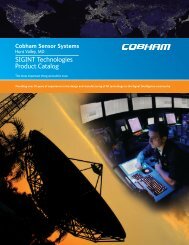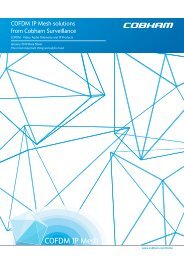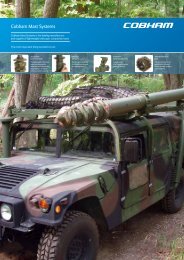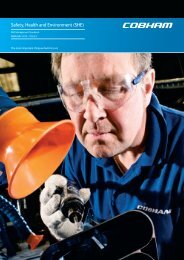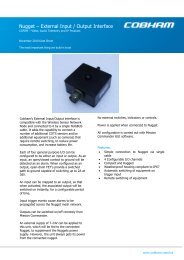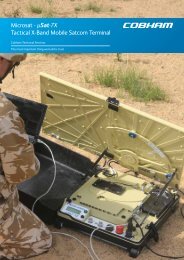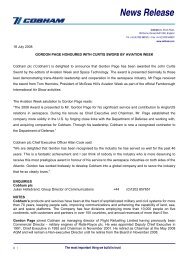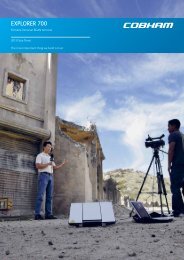installation an operation for sea tel model coastal 18 satellite tv ...
installation an operation for sea tel model coastal 18 satellite tv ...
installation an operation for sea tel model coastal 18 satellite tv ...
You also want an ePaper? Increase the reach of your titles
YUMPU automatically turns print PDFs into web optimized ePapers that Google loves.
Coastal <strong>18</strong> Ku-B<strong>an</strong>d TVRO Basic System In<strong>for</strong>mation<br />
3. Basic System In<strong>for</strong>mation<br />
This section provides you with some additional in<strong>for</strong>mation about the sa<strong>tel</strong>lites you will be using, basics of the<br />
your <strong>an</strong>tenna system <strong>an</strong>d other equipment within your system configuration.<br />
3.1. Sa<strong>tel</strong>lite Basics<br />
The Television Receive Only (TVRO) sa<strong>tel</strong>lites are in orbit at <strong>an</strong> altitude of 22,753.2 Miles (36,600<br />
kilometers) <strong>an</strong>d positioned directly above the equator. Their orbital velocity matches the Earth’s rotational<br />
speed, there<strong>for</strong>e, each appears to remain at a fixed position in the sky (as viewed from your location).<br />
3.1.1. Ku-B<strong>an</strong>d Frequency (10.95-12.75GHz) Sa<strong>tel</strong>lites<br />
Your <strong>an</strong>tenna c<strong>an</strong> be used with <strong>an</strong>y of the Ku-B<strong>an</strong>d (10.95-12.75GHz or a portion of these frequencies)<br />
sa<strong>tel</strong>lites that provide a strong enough receive signal level. The Low Noise Block Converter (LNB)<br />
installed on your <strong>an</strong>tenna determines the exact frequency r<strong>an</strong>ge you are currently able to receive. Other<br />
frequency r<strong>an</strong>ge LNBs are available <strong>for</strong> use with your <strong>an</strong>tenna.<br />
At these frequencies the signal from the sa<strong>tel</strong>lite travels only in a straight line <strong>an</strong>d is affected by weather<br />
ch<strong>an</strong>ges in the atmosphere. There are several conditions that c<strong>an</strong> cause a temporary loss of sa<strong>tel</strong>lite<br />
signal, even within <strong>an</strong> area where the signal level is known to be adequate. The most common of these<br />
normal temporary losses are blockage <strong>an</strong>d rain fade. They will interrupt services only as long as the<br />
cause of the loss persists.<br />
3.1.2. Blockage<br />
Blockage is loss due to <strong>an</strong> object in the path of the signal from the sa<strong>tel</strong>lite to the dish. If <strong>an</strong> object that is<br />
large <strong>an</strong>d dense is positioned in the path of the signal from the sa<strong>tel</strong>lite, it will prevent sufficient signal<br />
from arriving at the dish. The signal c<strong>an</strong> not bend around, or penetrate through, these objects <strong>an</strong>d the<br />
reception will be degraded or comple<strong>tel</strong>y interrupted. The dish is actively driven to remain pointed at the<br />
sa<strong>tel</strong>lite (toward the equator) so, as the boat turns a mast or raised structure of your boat may become<br />
positioned between the sa<strong>tel</strong>lite <strong>an</strong>d the dish. Blockage may also be caused a person st<strong>an</strong>ding near the<br />
radome, tall mountains, buildings, bridges, cr<strong>an</strong>es or other larger ships near your boat. Signal will be lost<br />
when the boat is housed inside <strong>an</strong> enclosure that the signal c<strong>an</strong>not penetrate, like a paint shed or a berth<br />
with a roof. Moving or rotating the boat to position the <strong>an</strong>tenna where it has <strong>an</strong> unobstructed view to the<br />
desired sa<strong>tel</strong>lite will restore the <strong>an</strong>tennas’ ability to receive the sa<strong>tel</strong>lite signal.<br />
3.1.3. Rain Fade<br />
Atmospheric conditions that may cause sufficient loss of signal level include rain, snow, heavy fog <strong>an</strong>d<br />
some solar activities (sun spot <strong>an</strong>d flare activity). The most common of these is referred to as “rain fade”.<br />
Rain drops in the atmosphere reduce the signal from the sa<strong>tel</strong>lite. The heavier the rain the higher the<br />
amount of signal loss. When the amount of loss is high enough, the <strong>an</strong>tenna will not be able to stay<br />
locked onto the sa<strong>tel</strong>lite signal. When the amount of rain has decreased sufficiently, the <strong>an</strong>tenna will reacquire<br />
the sa<strong>tel</strong>lite signal. In a strong signal area, rain fall of about four inches per hour will cause<br />
complete loss of signal. In weaker signal areas the effects would be more pronounced.<br />
3.1.4. Signal level<br />
The level of the receive signal is depend<strong>an</strong>t upon how powerful the tr<strong>an</strong>smission is <strong>an</strong>d how wide the<br />
signal beam coverage area is. Focusing the signal into a narrower beam concentrates its energy over a<br />
smaller geographic area, thereby increasing the signal level throughout that area of coverage. This<br />
makes it possible <strong>for</strong> you to use a smaller <strong>an</strong>tenna size to receive that sa<strong>tel</strong>lite signal. Your <strong>an</strong>tenna<br />
system must be geographically located in <strong>an</strong> area where the sa<strong>tel</strong>lite signal level is high enough to<br />
provide suitable reception. This limits the number of sa<strong>tel</strong>lites that c<strong>an</strong> be used <strong>an</strong>d the geographic areas<br />
3-1




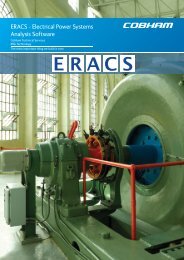
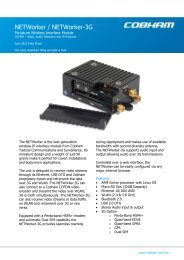
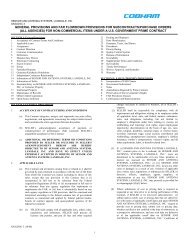
![NC1147 (pdf 1.47 mb) Nitrogen Concentrator [OBIGGS] - Cobham plc](https://img.yumpu.com/51124104/1/190x245/nc1147-pdf-147-mb-nitrogen-concentrator-obiggs-cobham-plc.jpg?quality=85)
